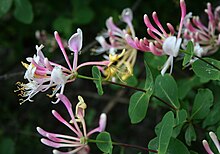| Lonicera etrusca | |
|---|---|

| |
| Scientific classification | |
| Kingdom: | Plantae |
| Clade: | Tracheophytes |
| Clade: | Angiosperms |
| Clade: | Eudicots |
| Clade: | Asterids |
| Order: | Dipsacales |
| Family: | Caprifoliaceae |
| Genus: | Lonicera |
| Species: | L. etrusca |
| Binomial name | |
| Lonicera etrusca Santi | |
| Synonyms | |
| |
Lonicera etrusca is a species of honeysuckle known by the common name Etruscan honeysuckle. It is native to Southern Europe, Western Asia and North Africa and it is known elsewhere, including the Pacific Northwest of North America, as an introduced species where it has escaped cultivation. It is kept in gardens as an ornamental plant.
Description
| This section does not cite any sources. Please help improve this section by adding citations to reliable sources. Unsourced material may be challenged and removed. (October 2021) (Learn how and when to remove this message) |
This is a deciduous perennial climber which can reach lengths of 6 meters. It is lined with oval leaves several centimeters long and bears dense spikes of flowers with pairs of fused leaves at the bases. Each flower has an elongated tubular corolla up to 5 centimeters long divided partway into two lips. The flower is light yellow to pale reddish-pink. The stamens and style protrude from the flower's mouth. The fruit is a bright red rounded berry.
Cultivars
Notable cultivars include 'Donald Waterer' and 'Superba'. The latter has gained the Royal Horticultural Society's Award of Garden Merit. It bears fragrant cream-coloured flowers, which age to yellow.
Other uses
In addition to the plant being grown as an ornamental, the leaves and flowers of L. etrusca var. etrusca are used as fodder on Mount Honaz and in its vicinity in the Denizli Province of Turkey.
Toxicity
The berries are poisonous, however they serve as an important source of food for some animals, namely Frugivores that live alongside L. etrusca.
References
- "The Plant List: A Working List of All Plant Species". Retrieved 7 December 2014.
- BSBI List 2007 (xls). Botanical Society of Britain and Ireland. Archived from the original (xls) on 2015-06-26. Retrieved 2014-10-17.
- NRCS. "Lonicera etrusca". PLANTS Database. United States Department of Agriculture (USDA). Retrieved 26 January 2016.
- "Lonicera etrusca Santi". Catalogue of Life. Retrieved 10 February 2021.
- "Etruscan Honeysuckle (Lonicera etrusca) - Plants". Candide.
- "RHS Plant Selector - Lonicera etrusca 'Donald Waterer'". Retrieved 29 October 2020.
- "RHS Plant Selector - Lonicera etrusca 'Superba'". Retrieved 29 October 2020.
- "AGM Plants - Ornamental" (PDF). Royal Horticultural Society. July 2017. p. 61. Retrieved 28 March 2018.
- https://www.researchgate.net/profile/Muhsin_Konuk/publication/225749741_An_Ethnobotanical_Survey_of_Inner-West_Anatolia_Turkey/links/0c960528d329b835d7000000/An-Ethnobotanical-Survey-of-Inner-West-Anatolia-Turkey.pdf?origin=publication_detail Kargıoğlu,Mustafa, Cenkci,Süleyman, Serteser,Ahmet, Konuk,Muhsin and Vural,GürselTraditional Uses of Wild Plants in the Middle Aegean Region of Turkey Human Ecology, Volume 38, Number 3, 2010. Retrieved 10.52 on 6 May 2018.
- https://www.botanical-online.com/english/honeysuckle-species.htm Retrieved 9.23 6 May 2018.
- Rojas-Nossa, Sandra V.; Sánchez, José María; Navarro, Luis (2021). "Phloem-Feeding Herbivores Affect Floral Development and Reproduction in the Etruscan Honeysuckle (Lonicera etrusca Santi)". Plants. 10 (4): 815. doi:10.3390/plants10040815. hdl:11093/2134. PMID 33924177.
External links
| Taxon identifiers | |
|---|---|
| Lonicera etrusca |
|
This Dipsacales article is a stub. You can help Misplaced Pages by expanding it. |